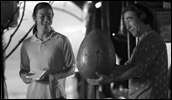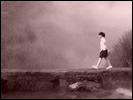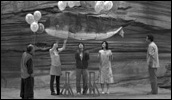The Buried Forest
- Year
- 2005
- Original title
- Umoregi
- Japanese title
- 埋もれ木
- Director
- Cast
- Running time
- 93 minutes
- Published
- 22 November 2005



by Tom Mes
David Lynch was once quoted, in an interview for French TV, as saying: "We all have personal tastes. Where they come from, we don't know, but those tastes can evolve or devolve. What worries me is that, in the present time, those tastes are devolving. Very few people are engaged with what is on a screen and what is in a painting. It's just a one-way, hollow thrill."
In other words, we have become so accustomed to a form of entertainment that reduces the receiver to an entirely passive spectator, that we no longer remember how to be active. We've lost the capacity to navigate our own way through a work of art. If it's a cliché to point the finger squarely at Hollywood, it is a fact that the Hollywood style of filmmaking has come to be seen as a kind of default form of cinema - the basic, proper way to make films - and all other forms, styles and approaches are regarded as alternative, viewed only in opposition to the Hollywood model. The American dominance in both the market and the writing of film history has created this impression and keeps it alive.
Let's take the silent cinema as a comparison. Not only did viewers in the early days of film have to rely almost solely on visual information - which demanded a much more active role from the audience in 'decoding' those images - but the films themselves were far more diverse, experimental and challenging. However we might like to see ourselves, 100 years ago cinema-going audiences were more sophisticated, capable and open-minded than those of today.
Lynch's words perfectly voice the concerns and philosophies of the director of The Buried Forest, Kohei Oguri. In what seems like an active form of resistance to the feverish pace of film production in Japan, Oguri has directed only five feature films in a 25-year career. The impact each of them has made, on the other hand, has been formidable. His 1981 debut Muddy River (Doro no Kawa) got him an Oscar nomination, a slew of festival prizes and a top spot in many Japanese film critics' top ten lists. Every film he has made since has gone on to similar acclaim, peaking with a Jury Grand Prize and a FIPRESCI award at Cannes in 1990 for The Sting of Death (Shi no Toge).
With each subsequent production, the balance between images and dialogue in Oguri's films has continued to tip over in favour of the former. His previous film Sleeping Man (1996, one of the movies that established Koji Yakusho as the premier actor of the decade) was so overwhelming in its use of landscape, that even Oguri's former student Katsuhito Ishii was inspired to abandon the love of rapid cutting and comic book characterisations he displayed in Shark Skin Man and Peach Hip Girl and Party 7, and make his own attempt at Ogurian cinema with The Taste of Tea.
The Buried Forest, like Oguri's previous films, is an attempt to reawaken our capacity to interact with images. The casual viewer might complain that there is no story, but they would be wrong. There is no plot, perhaps, but there are stories aplenty. There are little stories everywhere in the rich, radiant images of The Buried Forest, and Oguri gives us the time to find and read them all. He holds his shots and makes minimal use of the moving camera. The state-of-the-art HD material the film was shot on, whose detection of light is as close to that of the human eye as any lens or camera had, to that point, ever gotten, gives the images a life-like luminosity, whether shot by day or by night. Oguri's landscapes are breathtaking in their richness and detail, but they are not the self-consciously imposing vistas of white elephant filmmaking or the dullness of pictorialism - The Buried Forest was not shot in Cinemascope and is only 93 minutes long. Instead the film is an attempt to create truly rich visions in which the viewer can almost lose himself.
That same richness is applied to Oguri's human characters, who form part of those landscapes instead of being overwhelmed by them: three teenage girls passing the time by telling stories of camels and whales, a layabout youth whose goal is to keep a giraffe-shaped balloon afloat, an old lady whose obstinate refusal to be sent to a retirement home becomes the talk of the town, and the discovery of the petrified forest that gives the film its title and which reminds the townsfolk of the things that exist beyond their day-to-day worries and frustrations. Oguri tells all their stories with an imagination so fertile it regularly overtakes reality.
Some films can be summed up in words - in fact, doing this in as few as possible has become the benchmark of quality for the aforementioned Hollywood model of filmmaking. For others, like The Buried Forest, no amount of words can suffice, because words are exactly what they are not about. Checkmate for the film critic, then, but limitless possibilities for the viewer.